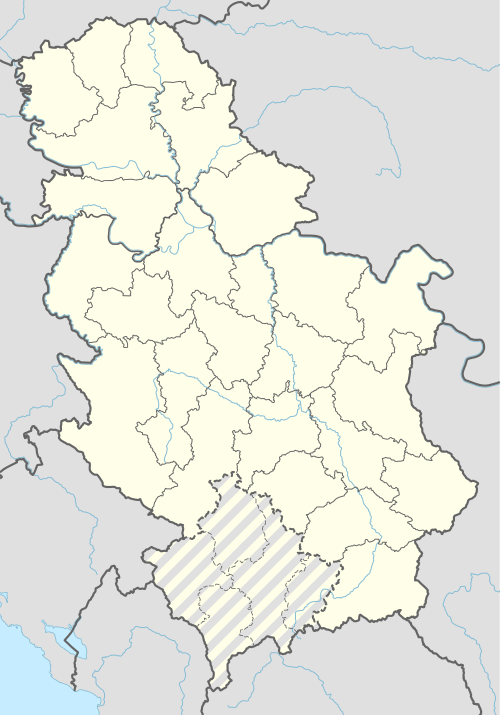Kale-Krševica
Kale-Krševica is an Ancient Macedonian[1] archaeological site of more than 4 hectares and so far some 1,000 squares have been excavated with a former fortified town in the hills of Krševica overlooking Bujanovac and Vranje, to the south of Ristovac in southern Serbia. It has a history back to the 13th century BC[2][3] as a settlement with elements of an acropolis, but main preserved characteristics is from the Greek-mediterranean style urban town in the 5th[4] or 4th century BC[2] (Bronze Age) with stone walls and necropolis.[1] Finds of coins of Philip II, Alexander III, Cassander, Demetrios Poliorketes and Pelagia correspond in general to the chronological span of the archaeological material discovered so far in the course of excavations[5] and may be considered the northernmost[6] Ancient Macedonian city. The Paeonian tribe of Agrianes dwelled in this region, the Scordisci are believed to have razed the town to the ground in 279 BC.[7] The town had at least 3,000 inhabitants in the 4th and 3rd century.[6]
Fortress of Krševica | |
|---|---|
 Fortress of Krševica Location in Serbia | |
| Coordinates: 42°26′36″N 21°51′37″E | |
| Time zone | UTC+1 (Central European) |
The town had an exceptionally strategic position on a plateau that descends from the Rujan mountain towards the South Morava and Vranje valley.[8] At the slopes of the plateau is a village where houses often have stone blocks from the ancient settlement. Its acropolis and suburbium encompasses 4 hectares extended to the valley of Krševička river.
Dr. Petar Popović from the Institute of Archeology in Belgrade says that the site could be the ancient city of Damastion.[9]
Findings
The first findings were recorded in 1966. Besides the foundations of the 13th century BC town, the 4th century BC findings are Hydriai,[10] painted Kantharoi and Skyphoi, 25 very rare golden coins from the time of Philip II and Alexander the Great valued at €50,000 each, Brnjica culture pottery of the early Iron Age (1200 BC).[11]
A textile industry.[12]
In 2001 the research around the site took a new turn with cooperation between the Belgrade Archeological Institute, National Museum of Serbia, Vranje National Museum and the University of Belgrade Faculty of Philosophy. .
Identical finds of pottery are in Cernica, Gadimlje, and in the Skopje basin.
External links
References
- "(02/12/03)Arheoloska izlozba o grckom lokalitetu Kale-Krsevica | SEEcult.org Portal za kulturu jugoistočne Evrope". Seecult.org. Retrieved 20 October 2011.
- "Microsoft Word - Media Report September 2004.doc" (PDF). Retrieved 20 October 2011.
- "IN novi broj". Kraljevo.com. Retrieved 20 October 2011.
- A. Davinić (28 July 2008). "Kultura : Otkrili ledenicu iz antičkog doba : POLITIKA". Politika.rs. Retrieved 20 October 2011.
- "Numismatic finds of the 4th–3rd centuries BC from Kale at Krsevica (southeastern Serbia)". Cat.inist.fr. Retrieved 20 October 2011.
- "Najseverniji grad Aleksandrovog carstva – Lokalitet Kale, Bujanovac". Trablmejker.com. Retrieved 20 October 2011.
- "Microsoft Word - CRDA SUCCESS STORY - Kale Archeology VR.doc" (PDF). Retrieved 20 October 2011.
- http://av.zrc-sazu.si/pdf/58/AV_58_Popovic.pdf
- "Kultura : Kale iznova iznenađuje naučnike : POLITIKA". Politika.rs. Retrieved 20 October 2011.
- "Diana: Center for Preventive Conservation". Narodnimuzej.rs. Archived from the original on 6 October 2011. Retrieved 20 October 2011.
- "Recueil du Musée National Belgrade: archéologie". Narodnimuzej.rs. Archived from the original on 7 October 2011. Retrieved 20 October 2011.
- "Article". doiSerbia. doi:10.2298/STA0656309P. Retrieved 20 October 2011.